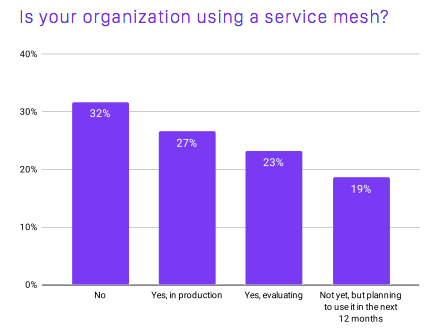Will Istio or Linkerd Dominate Service Mesh?
Istio has seen an uptick in adoption and now has the largest market share — albeit, by a slim margin — in the service mesh space, according to the results of the Cloud Native Computing Foundation (CNCF) survey released earlier this year. According to the report, Istio accounts for 47% of all service meshes used in production, while Linkerd trails slightly behind, with a share of 41%.
Some Istio proponents, such as executives from the Istio provider Solo.io, say the statistics reflect how Istio is outpacing the competition in the space as users seek to use service mesh to manage highly distributed microservices environments.
In his keynote at the recent Solo.io virtual conference, SoloCon.io, Christian Posta,, global field CTO at Solo.io, says Istio has become the “most popular and most dominant” service mesh deployed in production. “What we’ve seen over the last eight months is that service mesh is real and people are deploying it in production at a scale of hundreds of clusters and control planes — they’re solving real problems with it and Istio is the mesh that they’ve been picking,” says Posta.
However, Linkerd proponents and users interviewed for this article say, “Not so fast.” Chris Campbell, a cloud platform architect at HP, says instead of adoption statistics, he “has made most of my decisions based more on technical merit than trends.” He says his faith in Linkerd is reflected in how he also looks for a “vibrant community around any tool that you pick up.” “You don’t want to pick up a tool that’s going to be abandoned,” Campbell adds. His faith in Linkerd reflects his faith in the “Linkerd community as a whole,” says Campbell.

The Cost Factor
While both Istio and Linkerd are both open source stacks, the cost of the services and support required to adopt an open source alternative always remains a consideration. There is always a cost associated with maintaining, deploying and configuring any software option, “whether it’s open source or even free software,” says Campbell.
Campbell and his team found that the costs associated with implementing and maintaining Linkerd were more in line with their expectations, while Istio would have “meant a lot of refactoring of how we did our deployments and labeling and all that,” says Campbell. ”We installed Linkerd and everything was just working right — we didn’t have to add any extra configurations or anything like that. It worked right out of the box … while, with Istio, we would have had to make a bunch of changes to make everything work.”
According to Catherine Paganini, head of marketing at Buoyant, which also created Linkerd, many backers of Istio have vested commercial interests in Istio’s adoption (just as Buoyant has an obvious vested commercial interest in Linkerd).
“One thing to keep in mind when absorbing all the service mesh information is that Istio is pushed by companies like Google, IBM and all the other vendors offering production-ready Istio; all trying to tell you that Istio is the de facto standard because that’s how they make money,” says Paganini. “Linkerd, on the other hand, is production-ready by default. To counter the voices of loud vendors, our strategy is to let our users speak – that’s so much more powerful.”
Necessary Support
The commercial service element of any open source project is obviously important, whether mulling Linkerd or Istio adoption or any other software investment. As an example, Justin Turner, director of engineering at H-E-B, a Texas-based online grocery delivery service, and his team appreciated Buoyant’s support for Linkerd. The service mesh’s functionality has been especially critical during the COVID-19 pandemic, as online orders have surged at over 400 H-E-B locations in Texas and Mexico. Turner says he and his team appreciated Buoyant’s support during chaos engineering tests before deployment, to see how it performed “when things get really bad,” and since its rollout, as the company transitioned from a monolithic data center to a microservices environment network.
“One of the key things when you adopt a service mesh is understanding it, especially when you’re operating something as complex and as important as getting people their food and slowing the spread of COVID-19 for potentially immunocompromised customers,” says Turner. “We couldn’t take on a lot of risk, and so, as we evaluated different offers, Linkerd stuck out as easy to understand, simple and it solved the use cases that we needed, which was networking our services.”
As with any technology choice, make the one that works best for your unique business, your end users and that fits your budget, and you can’t go wrong.




